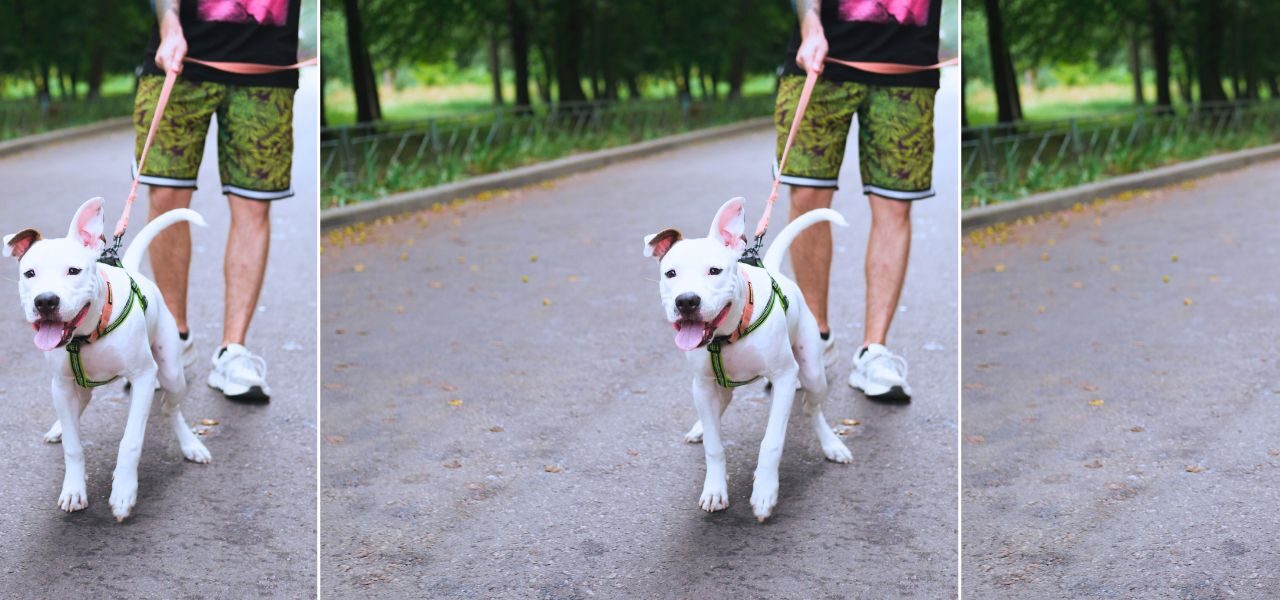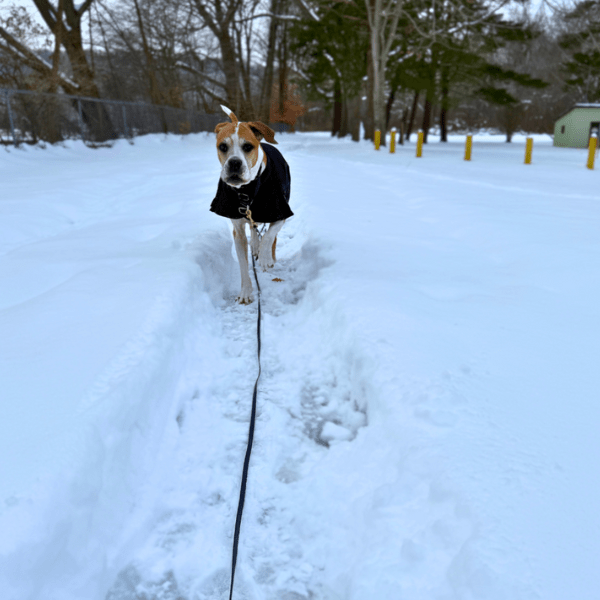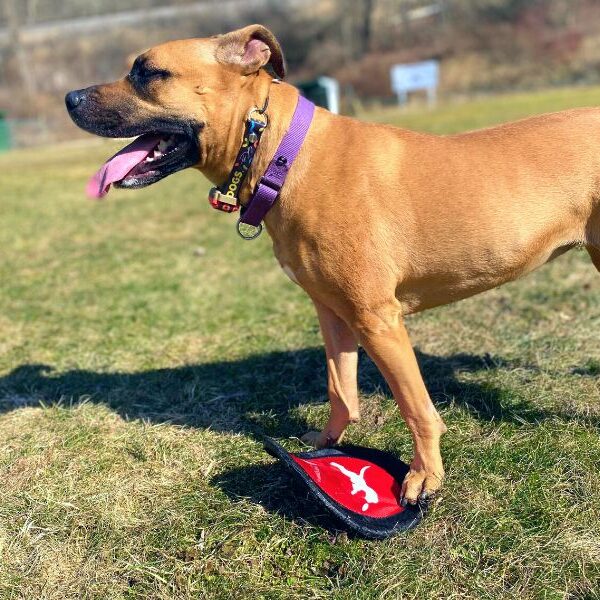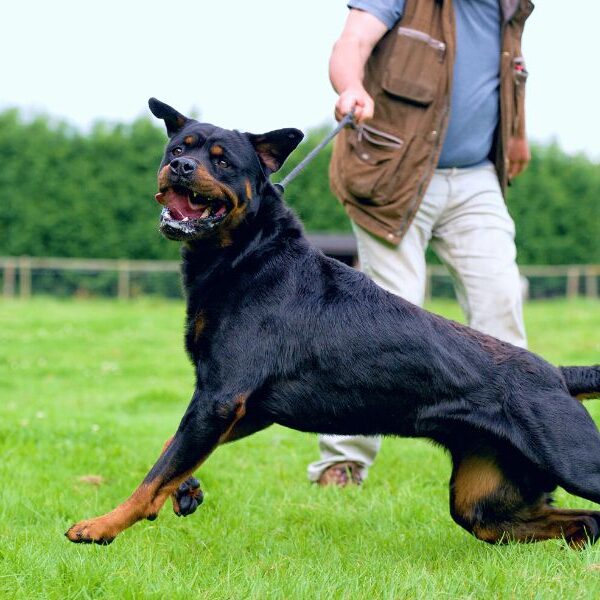
When my dog turned two, she started turning into a leash reactive dog. I felt so overwhelmed with her. I had no idea what to do!
5 years later, I have done all the work myself to train my dog, and now she is able to help me train other dogs! It truly is a full circle experience. However, there are some things I wish I had done differently, sooner, changed or had skipped altogether!
In this post, I'll share and rate the 18 things I tried with my reactive dog.
Related: Dog Training for Reactive Dogs | 6 Secrets from a Dog Trainer

Leash Reactive Dog
Reactive Dog Breeds
As a dog trainer, I have met with all sorts of breeds that are reactive from Golden Retrievers, to Border Collies, Heelers, Shepherds and St Bernards. There are so many things that play into a dog's likelihood of becoming reactive.
Their environment, nutrition, the owner, the amount of exercise the dog gets, their personal history and training history, and genetics all play a roll in your dog's behavior on a leash.
Related: Dog Training Exercises for a Reactive or Anxious Dog
I won't say one type of dog breed is more likely to develop leash reactivity, because there are just too many factors that play into developing a leash reactive dog.
In my own experience, my dog had a genetic component for needing a high level of daily exercise, I took her to the dog park and allowed her to be bullied by other dogs at a young age, and my inexperience with a high drive dog made a potion for extreme reactivity.
1. I stopped walking her around other dogs.
7/10 recommend
When my dog was a puppy and up until about a year and half of age she LOVED other dogs! At least, from what I could tell. So, it took a few escalating events for me to see that she was struggling and developing into a leash reactive dog.
Related: How to Stop a Dog from Pulling When Seeing Another Dog
She was also super strong, so I was genuinely afraid that I wouldn't be able to hang on to her when we saw another dog.
So, we started avoiding other dogs altogether.
To this day, my dog and I will still avoid dogs we don't trust and situations that we are not prepared for. I believe this is one of the greatest ways to build trust with your dog and maintain a good relationship with your pup.
How to stop a dog from lunging on a leash
2. I hired a trainer
10/10 recommend (hiring the RIGHT trainer)
It took a few months, but I eventually admitted I needed help. I felt a little defeated because after all, "I'm a vet assistant and I've had dogs my whole life. I should be able to fix this myself." Plus, I didn't want to pay for a trainer. They're not cheap!
I delayed this step much longer than I should have. Do this one if you want to save time and energy and to prevent long-term damage to your dog. Really, do this step as soon as you're able to.
BUT, make sure you find the right trainer for you. I had hired a trainer who fit my budget, rather than my needs. The first trainer I hired was helpful (I'd rate her helpfulness 4/10). She showed me things that I still use today (like marker words), but she did not fix our reactivity in a realistic way.
If I could do it again, I think I should have paid for a trainer who worked with a leash reactive dog more regularly (and successfully).
3. I tried medicating my dog
1/10 recommend
I did not love this one, but I was so tired. I just wanted to walk my dog, not a loaded gun. I had given her trazodone for thunderstorms or fireworks. And I just tried it one day before a walk and I thought "wow, she is so pleasant to walk."
But, I felt like I didn't have my dog. She just wasn't herself when she was on trazodone. So I only tried this one a handful of times. I knew I wasn't fixing the problem.
If I did it all over again, I'd just avoid this one until you've exhausted all training methods with consistency. Medication is rarely the solution.
Dog aggressive on leash but not off
4. I tried the Alpha Roll **cringes**
-5/10 recommend
I'd really like to bury my head in the sand about this one. And in fact, I almost didn't include this in my post, but.. here we are. This is a list of ALL the things I tried.
At the advice of my friend.. who has her own methods (that apparently work for her), she introduced me to the alpha roll. I was not sure what to think of at first. But, being willing to try most things, I gave it a shot.
However, I think my dog was just utterly confused by it and thankfully had a sense of humor about this short-lived-alpha-roll phase of my life.
She was respectful, but rolling her onto her back as soon as she started reacting really didn't change anything with us. And, I just looked like an idiot. Luckily, I never did this one in public.
Plus, I just don't have the alpha personality to go along with the alpha roll. So I don't think she believed me.
Thank god my dog is forgiving.
5. I watched youtube videos
8/10 Recommend
One day I stumbled across a trainer who's message and methods registered with me. I ate up all of their content and eventually paid for a subscription to watch more specialized videos.
Youtube University is a real thing. I learned so much from this. Not just about my dog, but about lots of things related to dog behavior.
The only thing that was different is I didn't really feel like I saw a dog in the videos that matched my dog's energy. So, I wasn't always sure how to handle the specific quirks my dog had.
Dog Whisperer Leash Reactivity
6. I went to dog parks
5/10 recommend
After gaining soooo many more skills from youtube university, I took my dog to practice at a dog park.
Before you come for me- A dog park is a great place to practice if you stay OUTSIDE of the park and allow your dog to observe. After all, I credit my decision to take her to the dog park as a lot of the reason I ended up with reactivity in the first place.
This was such a helpful way for my dog to see other dogs interacting and playing, without feeling defensive. Of course, at first she wanted to bark and lunge, but after some time and our training kicked in, she was a super star.
It was helpful, and a great way to train. However, I felt like it didn't quite compare to seeing a dog on a walk. The skills needed to walk towards a dog head on are quite different from watching a group of dogs play at a distance.
7. I practiced obedience
9/10 recommend
Obedience is like my plan B for reactivity. Obedience can often override negative behavior- if practiced well.
Related: Teaching a Dog to Sit (So They Actually Listen the First Time)
Obedience is not a replacement for relaxation training (Plan A). But doesn't always help you if the trigger is over threshold and you need to use plan C (walking away).
The only reason I didn't give this a 10/10 is because obedience cannot save everything for you. An obedient dog isn't always calm, but a calm dog is likely to be obedient (or not even need the obedience.)
Practicing obedience develops the relationship further. Obedience encourages the dog to follow leadership and develops you as a handler. Obedience teaches you to follow through on things you said.
Dog Reactive on Leash to Other Dogs
8. I paid for training subscriptions
9/10 Recommend this one.
All the information you could ever want to learn is on the internet somewhere (probably even for free). However, I did find that when I paid for some information, it was organized in a way that I could understand and implement.
There are so many trainers out there, and you have to find one that resonates with you and your dog's needs. Otherwise, you're not going to use it, or it won't work.
9. I bought a stuffed dog
Lol. 3/10 Recommend.
I saw this stuffed dog in a youtube video at one point and I thought that this must have been the missing link to fixing my leash reactive dog. (Spoiler: A stuffed dog does not replace hard work and consistency, LOL!)
I'd seen a couple trainers work with them on youtube, and thought it might help my dog become more confident around other dogs.
In reality, a distraction is a distraction is a distraction. Practicing obedience and relaxation across multiple different triggers and environments is what matters. And you don't have to go out and spend money on a fake dog. There are triggers and distractions all around you.
What I found was using a fake dog was just a weird distraction that my dog really didn't understand how to react to. I think these fake dogs are great for understanding a dog's intent when they see another dog, but as a personal investment, spend the money on more education.
Best Harness for Leash Reactive Dogs
10. I tried a LOT of training tools.
6/10 recommend
There are a lot of training tools out there ranging from no pull harnesses to shock collars to clickers and pagers.
Related: Dog Training Essentials | 17 Tools to Improve Your Dog's Behavior
Now that I have experience in training reactive dogs, there is not really a one size fits all approach, but there are definitely wrong sizes, especially if you are not using the tool the way it's designed to be used.
What's the saying? A pillow can be more deadly than a hammer in the wrong hands.
While I tried a few different things, I can say with 99% confidence, if you are using a harness for a reactive dog, things are not going to progress quickly. And on the other hand, if you have a collar that uses electric shock, it's unlikely you're building any kind of trust with your dog.
Also, YOU have to be comfortable using the tool. If you are not comfortable, then you are not going to use it, and then you're going to be inconsistent and neither you nor your dog will be happy.
Finding the right equipment for you is where our next step comes in.
Leash Reactive Dog Training
11. I hired a second trainer
10/10 recommend
Well, I mostly recommend hiring the right trainer the first time around, but if you weren't successful with your first trainer, a second opinion is worth it!
While I had pretty much worked through most things, there was still lingering reactivity that I felt I couldn't manage. We'd gone from a loaded gun to a loaded gun that was much lighter to point somewhere else.
I finally worked with a second trainer who had a lot more experience in reactivity and it changed EVERYTHING.
This was the key to really unlocking where we were stuck and what I couldn't see because I'd been working on the problem for four years.
12. I worked with other dogs
6/10 Recommend
In my own interest (and on my own time), I spent some time working with shelter dogs and training them. This was helpful to gain a more well-rounded knowledge of dog behavior and I was starting to prepare to open my own shop for dog training services.
Not a necessary step, but it definitely helped me become more objective with my own dog's behavior and a more creative problem solver.
Leash Aggression Towards Humans
13. I gave myself patience
9/10 recommend
Having a dog who is or was reactive is HARD work. Tomorrow will not always be better than today. Bad days can be really bad, and even scary.
Allow yourself grace and compassion to understand that dogs, just like humans, have good days and bad days. And when you're ready, ask yourself what you missed that didn't set your dog up well for success.
14. I filmed myself
11/10 recommend
It was SOO helpful to see what in the world I was actually doing with my dog. You are your biggest critic, and after watching so many youtube videos, I thought my timing, markers, and decisions were perfect.
Upon filming and reviewing, I was indeed, very wrong. I quickly dropped some of my bad habits because I was aware of them and could see them with an objective point of view for the very first time.
I also was able to watch them when I wasn't under pressure, and therefore had a clear head to review how I made decisions.
15. I learned to advocate for her
100/10 recommend
At the end of the day, your dog is reacting and "handling" the situation because they don't trust you to.
This lesson took me a long time to learn, but my dog didn't actually want to fight another dog. She was uncomfortable and reacting was the behavior she felt she needed to do to keep herself safe.
We'd be approached by multiple off-leash dog and I wasn't standing up for her. Once I started advocating for her and helping her feel comfortable on leash, she started to trust me and her behavior started to change.
But my attitude and understanding about her reaction had to change first.
Leash Reactive Dog Training Near Me
16. I changed things around the house.
7/10 recommend
Time for some tough love. You can't expect change on the outside of the house, without changing a few things inside of the house.
I changed up how I allowed her to go in and out of doors. I changed the routine with her meal time and her access to the house. I changed how I reacted when she barked at the window.
We worked on things around the house in order to promote calmness and leadership, so that she wasn't shell shocked when I demanded calmness outside of the house.
I rated this one lower because this part sucked. It sucked because I love my dog and I want to see her happy and share everything with her. However, those unearned privileges were not serving either of us, and actually making life worse for both of us.
17. I got her involved in protection work
8/10 recommend
Once we were really making some progress, I decided to enroll my dog in protection work. This way she had some fulfillment and extra enrichment in her life.
Bonus, this was SO much fun for me to see her excel at this!
It can be difficult to find a trainer who is local and willing to work with you. But, she really appreciated the outlet to channel all of her drive!
Best Collar for Leash Reactive Dogs
18. I practiced impulse control with "Happy Triggers"
8/10 recommend
When your dog is excited, our natural reaction is often to let them be excited and go to the thing that's making them excited (food, a person, a toy). However, this is a great time to practice impulse control.
Don't wait until your dog is showing an inappropriate deficit in impulse control to practice their skills. Practice when your dog shows a deficit in being able to wait for their food, to greet a family member or to fetch the ball.
Whether it's negative or positive, it's still an impulse the dog wants to act on, and a safe way to practice their control!





